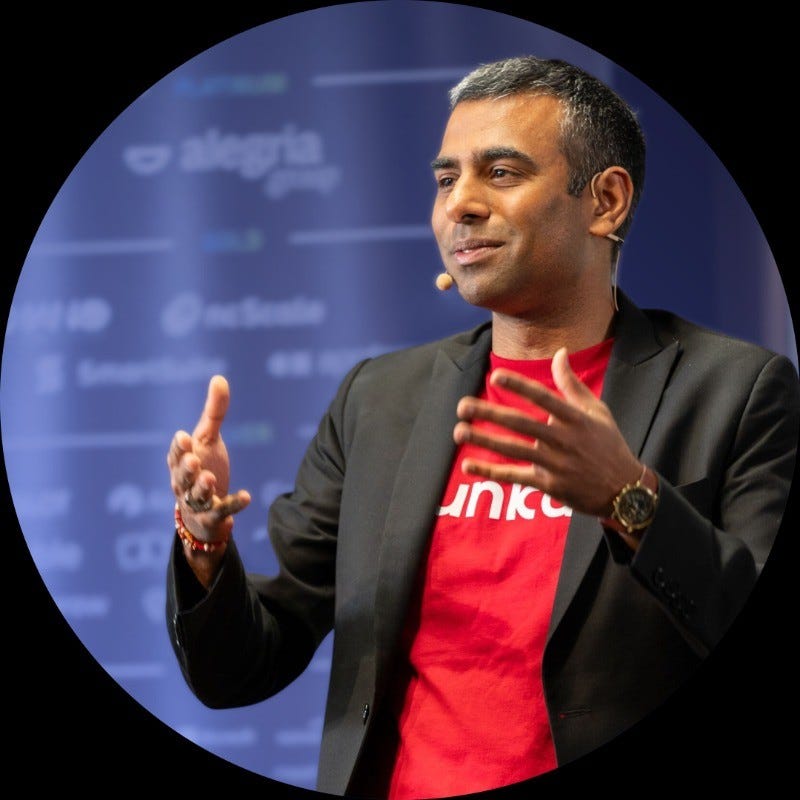How AI will Impact our Future: Lessons from the MIT AI Conference – Part II
How AI will impact the future of work, business models, and society
Welcome! I'm David Martin and this is my tech newsletter. If you’ve received it, then you either subscribed or someone forwarded it to you. If you fit into the latter camp, then you can subscribe by clicking on this handy little button:
Let’s jump into it…
Build. Build. Build. The words were a frequent refrain on stage, and an apparent mantra hammered into these MIT alum. I attended the MIT AI Conference for the second time – the first time being in 2017 - and both were days well spent and packed with insight. It’s an alum conference, so the atmosphere is more cordial and relaxed than your average tech conference. It was also held on a Saturday, so the attendees were primarily there to learn. A dozen or so even made it a family affair. I am a fan – and I’ll be back next year.
Special note: I split this post into two parts to make it easier to digest. Part one is here.
In part two, we’ll get into these topics and summarize the key takeaways:
The future of work
New business models
Societal impact
Summary
In part one, we covered these topics:
Agents – the next tangible step
Incumbent ‘big tech’ vs. challengers
Closed vs. open source models
The future of AI models
The future of work
Today, working with ChatGPT on more complex tasks requires either skillful prompting or repeated back and forth – a human-in-the-loop activity. Mark Gorenberg, Managing Director at Zetta Ventures and Chair of MIT Board of Trustees, polled the audience, asking if they had already tried GitHub Co-Pilot, where AI writes 40% of checked-in code. He said we used to draft documents and then have machines review them, but in the future, we will have machines draft documents, and we will review them – a fundamental switching of roles.
But it’s not enough to complete the task; agents must also be trustworthy and inspire confidence. Kanjun Qiu, CEO & Co-Founder of Imbue, talked about her company’s definition of reasoning and how functional AI agents need to deeply understand you as an individual, grasp your specific role in each context, and have a framework for the given task without getting detailed instructions from you. Agents also need to be self-aware and ask questions when they don’t have enough information. Her example was booking a red-eye flight and how an agent should pick a window seat so she can sleep and already has her TSA-precheck number. The company raised $200M to develop AI systems that can reason and code—‘imbuing’ computers with intelligence and human values so they can help us accomplish larger goals in the world.
New business models
In the enterprise segment, Sam Shalabi, CTO & Co-Founder of Maven, talked about how agents impact business models:
“A lot of SaaS businesses, their models tend to be around seats, and now we’re actually in a world where humans aren’t doing all the work, and it’s, I think, going to end with this state where we’re going to be creating a bunch of more value-based businesses as opposed to the number of people using it because bots are now on the path to be able to solve problems in the enterprise.”
- Sami Shalabi, CTO & Founder, Maven
The term “value-based businesses” can be interpreted loosely as disrupting and replacing existing systems with agent-based programs that see across a company or, more tightly, as making humans more productive and needing fewer of us to achieve the same output. Either way, companies can monetize and capture value with any of the following: a percentage of a solution’s savings/earnings, additional human time saved through agents, or a reduction in headcount through complete automation.
Societal impact
Even with today’s AI tools that assist and augment, empowered solopreneurs can be more productive with marketing assistants, full-on coding co-pilots, and no-code/low-code platforms that integrate with AI. Sam Altman describes this upside:
“On the positive side, like with any other technological revolution, maybe more than any before, the amount of work that one person will be able to do, the amount of leverage on ideas and creative spirit that will come from this, the ability to build creative, amazing new things to do existing jobs way better, and to think of entirely new categories of jobs that can scarcely be imagined today.”
- Sam Altman, CEO, OpenAI
Over the next few years, there will be a shift in the workplace, and knowing how to use AI assistants will be table stakes, much like Microsoft Office today. The reality is that AI will create new jobs and make some of today’s jobs redundant:
“I think it is very important to acknowledge that some jobs are just going to go away and other jobs are going to be worse than they are today. And although that is the way of technology and all of it is net good for society, it doesn’t mean it’s not an incredibly painful thing… Like there is in every technology revolution, and it is easy to be too dismissive of that… but it’s going to be a disruption to people’s lives.”
- Sam Altman, CEO, OpenAI
There’s a virtuous loop where today’s workforce will use AI to be more productive and, in the process of using it, will train future versions of AI to be even more capable, making more of those tasks automatable. Arun Saigal invites us to question what human work is today and will look like tomorrow:
“The cool part about AI is it makes us ask the question. What do we care about as humans? Who are we? What do we want to do? What do we appreciate? Everything else the machine will do. And the really cool experiences, the drawing, the music, the story behind all of that. That’s what we get to do… Whatever the machines can do, that’s no longer human. It’s redefining what human tasks are… AI is that next step-function that is allowing us to level up.”
- Arun Saigal, CEO/Co-Founder, Thunkable
As agents become more effective, we must re-evaluate and redefine what ‘creative’ and ‘human’ jobs are. The asterisk here is that drawing, writing lyrics, creating music, and writing story arcs are all skills AI can help with today – these definitions will change and potentially shrink over time.
Schools also need to recalibrate because now we have a double standard between white-collar workers using AI at work and their children at school, where institutions almost lump ChatGPT and illegal drugs into the same category. Richard Socher was the only speaker who brought this up:
“It’s kind of funny when your parents use the tool at their work every day, and then the school doesn’t allow you to use the school. I think that shows that the school needs to update… It might make sense to update classwork to say hey, here’s already the GPT4-generated text, you verify whether or not it is correct because that is the kind of job that they will have to do… AI will do the grunt work for you.”
- Richard Socher, now CEO/Founder of you.com
The huge caveat is that we, as humans, must have the knowledge, awareness, and intellectual capacity to verify an agent’s work. Sal Khan breaks this down:
“In some ways it will make everyone into a manager, into a software architect, into an editor-in-chief, from a screenplay writer into a movie producer. And in that world, though, you should be able to do those skills reasonably well in order to manage, curate, and put the pieces of the AI together… GPT-4 operates at the 80th percentile of the LSAT… You’re going to want to be a little bit ahead of that, or at least be able to hang with it so that you can manage it. I don’t subscribe to this: AI technology can do it, so kids don’t have to learn it. I think it’s the opposite, but hopefully, we can use the technology to do that.”
- Sal Khan, Founder, Khan Academy
Let’s summarize:
Today, most AI can assist and augment us, and agents will enable automation.
In 2024 and beyond, entrepreneurs have plenty of AI gaps and opportunities to fill. Reason, lower latency experiences for real-time applications, and reducing the environmental impact of models ranked highly at the conference for startups to tackle.
When companies build products with new technology, they often start with an old way of thinking, like porting a full Windows app to a mobile phone such that the application is no longer as useful in this new context. The actual user benefit comes from rethinking the paradigm and the workflow, which opens opportunities for challengers and startups because people are adjusting to new habits and ways of interacting.
The future will include both open-source and proprietary models, and the latter will be much more capable than the former.
Today, ChatGPT is and will be a learning tool, as seen through Khan Academy’s Khanmigo, but as an agent’s ‘manager,’ you need to be one step ahead of it.
As enterprises adopt agents, business models will move away from seat-based pricing to value-based pricing, so entrepreneurs and their advisors must rethink their pricing models from the ground up.
AI is coming, and businesses will adopt it over the next two to three years, so most workers will need to upskill, or companies/governments will need to retrain them. It’s the new skill equivalent of “adept at Microsoft Office” at the bottom of a recent college grad’s resume.
I especially thank Ken Yeung and Katy Hunt for their feedback and advice on these posts and the newsletter.
If you missed part one, check it out here.








